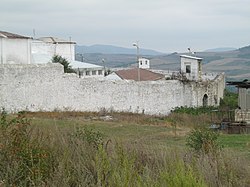| Aghoghlan Gate | |
|---|---|
| Shusha, Azerbaijan | |
 | |
| Coordinates | 46°44′58″N 39°45′55″E / 46.74944°N 39.76528°E / 46.74944; 39.76528 |
| Type | Castle walls |
| Site history | |
| Built | 1750 |
| Materials | Stone |
Aghoghlan Gate (Azerbaijani: Ağoğlan qapısı), also known as the Mukhtar Gate (Azerbaijani: Muxtar qapısı) or the Shushikend Gate (Azerbaijani: Şuşakənd qapısı), is one of the four entrance gates to the Shusha fortress in the homonymous city in the Republic of Azerbaijan.
The fortress and the city came under the control of the self-proclaimed Republic of Artsakh following the capture of Shusha on 8 May 1992 until 8 November 2020 when Azerbaijani Army captured the city after a 3-day long battle.
Description
In compliance with medieval traditions in urban development of the khanate period, the walls of the Shusha castle were built with four gates: The main gate was facing north towards the road to Ganja and was therefore named Ganja Gate. The western gate was facing western regions, including the Iranian Erivan Khanate, and was hence called Iravan Gate. The other two gates opened to surrounding highland villages.
The road from the gate of the fortress, built during the reign of Panah Ali Khan, connected the city of Shusha with the villages of Shushikend and Mukhtar and extended to Agoghlan castle. In all Russian-language sources of the 19th century, the southern gate of the city was mentioned as Agoghlan Gate. In the 19th century, the Shusha prison was built in the lower part of the fortress, near the eastern gate. During the construction of the prison, part of the castle walls and defense towers were used as prison walls.
Another name of this door mentioned in the sources is Topkhana gate.
References
- ^ Карта к дорожнику Кавказского края. (1845). Кавказский календар на 1846 год. Тифлис.
- "ДРЕВНИЙ ГАРАБАГ". Retrieved 9 August 2010.
- War Against Azerbaijan – Targeting Cultural Heritage. Ministry of Foreign Affairs, Republic of Azerbaijan. 2007. ISBN 978-9952-8091-4-5.
- "Karabakh Foundation – Shusha". Archived from the original on 4 October 2010. Retrieved 9 August 2010.
- "Ministry of Culture – Shusha city". Retrieved 9 August 2010.
- "INFORMATION ON HISTORICAL AND ARCHITECTURAL MONUMENTS OF OLD SHUSHA" (PDF). Retrieved 9 August 2010.
- Очерки Закавказья. "Иллюстрация" (т. VII ed.). СПб.-М. 1861. p. 257.
{{cite book}}: CS1 maint: location missing publisher (link) - Авалов, Э. В. (1972). "О некоторых особенностях архитектуры оборонительных сооружений Шуши". Изв. АН Азерб. ССР сер. Лит. Яз. и Иск. (2).
- Nersesov (Qarabaği), Mirzə Yusif (2006). Tarixi-Safi (PDF) (Qarabağnamələr. II kitab ed.). Bakı: Şərq-Qərb nəşriyyatı. p. 35.
| Shusha State Historical and Architectural Reserve | |||||
|---|---|---|---|---|---|
| Shusha fortress | |||||
| Square and neighbourhoods | |||||
| Palaces and houses |
| ||||
| Caravanserais | |||||
| Temples |
| ||||
| Bathhouses | |||||
| Springs | |||||
| Museums | |||||
| Monuments | |||||
| Other | |||||